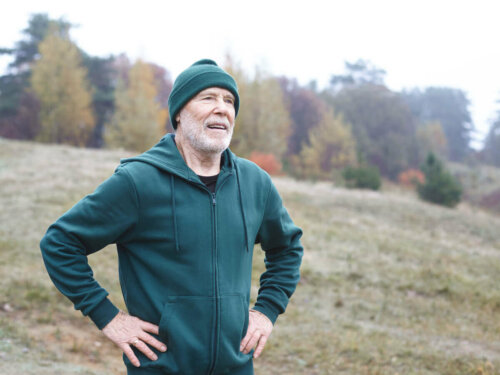Breathing Techniques for Good Performance

During physical activity, breathing increases to allow more oxygen in the body and thus, increases energy production. In this article, we’ll tell you about breathing techniques that could be useful for physical activity and sports training.
Importance of breathing for muscles
After inhalation, the oxygen descends until it reaches the lungs. At that time, gas exchanges take place in the pulmonary alveoli, through blood vessels.
When this oxygen reaches the pulmonary alveoli, whose wall is highly vascular, hematosis occurs, that is, oxygenation of the blood. Afterward, the oxygen travels through the blood to finally reach the muscle, at the level of the mitochondria.
There, glucose or lipids are metabolized to produce the energy necessary for muscle contraction. As a final step, carbon dioxide passes from the blood to the alveoli to be eliminated in the exhalation phase.
When the amount of air inhaled by the lungs is insufficient, the blood can’t be properly purified and the organs don’t get the energy they need to function as they should.
As a consequence, it can affect your performance if you don’t breathe properly. In the next section, we’ll talk about diaphragmatic breathing, a technique that helps you to better use your full lung capacity.
Diaphragmatic breathing
The diaphragm is very important during breathing. When you breathe in, it contracts and becomes flatter, allowing the chest cavity to increase in volume and let air into the lungs. When the diaphragm relaxes, it presses on the lungs and the expels air to the outside.
We define the breathing that people normally do as thoracic. This is located in the middle and upper areas of the lungs. In the majority of cases, it doesn’t use the lower area, which is the largest area.

For this reason, it takes a greater number of respiratory cycles to provide the body with the oxygen it needs. This increases the heart rate and leads to inefficient breathing.
Using your diaphragm will increase the volume of oxygen that reaches the lungs, due to its descent towards the abdominal area. This makes it easier for the air to reach the lower part of the lungs and logically occupy the entire storage space.
First, the lower part of the lungs (abdominal phase) is filled, then the middle part (thoracic phase), and finally, the highest part is filled. This is called the clavicular phase and it allows you to take a full breath.
Conversely, using your diaphragm during breathing allows you to eliminate a greater amount of carbon dioxide, thanks to the upward push it makes during exhalation.
We should note that breathing through the nose is often recommended, but if you’re doing high-intensity training, it’s likely that you won’t get enough oxygen. Therefore, it’s best to make sure breathing is comfortable so that you can guarantee your body is getting enough oxygen.
Every sport is different
Keep in mind that not all sports work the same physical abilities. Therefore, energy demands, oxygen debt, and type of breathing will also vary.
For example, in cardiovascular activities such as cycling, walking, running, or swimming, breathing should be regular and rhythmic, not forced. Generally, exhalation should be longer than inhalation and, depending on the pace of physical activity, you should find a steady respiratory rate.
On the other hand, in bodybuilding, when working on muscular hypertrophy, the most common technique is to inhale in the eccentric phase and exhale in the concentric phase.

Benefits of breathing techniques
By using a breathing technique such as the diaphragm technique, both dynamically and statically, you can achieve the following benefits in addition to improved performance:
- Decreased heart rate while exerting yourself.
- Reduction of maximum respiratory effort for each breath.
- Deeper breath.
- Improved post-exercise recovery.
- Improved perception of effort.
- Strengthened respiratory muscles.
- Better respiratory efficiency.
- Improved performance and physical condition.
Breathing techniques for increased performance
In sports, you also have to train your breathing to improve performance. Having control of your breathing will help you optimize energy and, therefore, will also reduce fatigue. Feel free to put diaphragmatic breathing to the test to compare your results!
During physical activity, breathing increases to allow more oxygen in the body and thus, increases energy production. In this article, we’ll tell you about breathing techniques that could be useful for physical activity and sports training.
Importance of breathing for muscles
After inhalation, the oxygen descends until it reaches the lungs. At that time, gas exchanges take place in the pulmonary alveoli, through blood vessels.
When this oxygen reaches the pulmonary alveoli, whose wall is highly vascular, hematosis occurs, that is, oxygenation of the blood. Afterward, the oxygen travels through the blood to finally reach the muscle, at the level of the mitochondria.
There, glucose or lipids are metabolized to produce the energy necessary for muscle contraction. As a final step, carbon dioxide passes from the blood to the alveoli to be eliminated in the exhalation phase.
When the amount of air inhaled by the lungs is insufficient, the blood can’t be properly purified and the organs don’t get the energy they need to function as they should.
As a consequence, it can affect your performance if you don’t breathe properly. In the next section, we’ll talk about diaphragmatic breathing, a technique that helps you to better use your full lung capacity.
Diaphragmatic breathing
The diaphragm is very important during breathing. When you breathe in, it contracts and becomes flatter, allowing the chest cavity to increase in volume and let air into the lungs. When the diaphragm relaxes, it presses on the lungs and the expels air to the outside.
We define the breathing that people normally do as thoracic. This is located in the middle and upper areas of the lungs. In the majority of cases, it doesn’t use the lower area, which is the largest area.

For this reason, it takes a greater number of respiratory cycles to provide the body with the oxygen it needs. This increases the heart rate and leads to inefficient breathing.
Using your diaphragm will increase the volume of oxygen that reaches the lungs, due to its descent towards the abdominal area. This makes it easier for the air to reach the lower part of the lungs and logically occupy the entire storage space.
First, the lower part of the lungs (abdominal phase) is filled, then the middle part (thoracic phase), and finally, the highest part is filled. This is called the clavicular phase and it allows you to take a full breath.
Conversely, using your diaphragm during breathing allows you to eliminate a greater amount of carbon dioxide, thanks to the upward push it makes during exhalation.
We should note that breathing through the nose is often recommended, but if you’re doing high-intensity training, it’s likely that you won’t get enough oxygen. Therefore, it’s best to make sure breathing is comfortable so that you can guarantee your body is getting enough oxygen.
Every sport is different
Keep in mind that not all sports work the same physical abilities. Therefore, energy demands, oxygen debt, and type of breathing will also vary.
For example, in cardiovascular activities such as cycling, walking, running, or swimming, breathing should be regular and rhythmic, not forced. Generally, exhalation should be longer than inhalation and, depending on the pace of physical activity, you should find a steady respiratory rate.
On the other hand, in bodybuilding, when working on muscular hypertrophy, the most common technique is to inhale in the eccentric phase and exhale in the concentric phase.

Benefits of breathing techniques
By using a breathing technique such as the diaphragm technique, both dynamically and statically, you can achieve the following benefits in addition to improved performance:
- Decreased heart rate while exerting yourself.
- Reduction of maximum respiratory effort for each breath.
- Deeper breath.
- Improved post-exercise recovery.
- Improved perception of effort.
- Strengthened respiratory muscles.
- Better respiratory efficiency.
- Improved performance and physical condition.
Breathing techniques for increased performance
In sports, you also have to train your breathing to improve performance. Having control of your breathing will help you optimize energy and, therefore, will also reduce fatigue. Feel free to put diaphragmatic breathing to the test to compare your results!
All cited sources were thoroughly reviewed by our team to ensure their quality, reliability, currency, and validity. The bibliography of this article was considered reliable and of academic or scientific accuracy.
- Beltrán, M. J. C., & Abad, P. (2011). La respiración consciente como factor principal de la relajación en la educación física escolar. EmásF: revista digital de educación física, (13), 19-31.
- Galilea Muñoz, J. (1964). Regulación de la respiración durante el esfuerzo. Apunts Medicina de l” Esport (Castellano), 1(002,003), 7-14.
This text is provided for informational purposes only and does not replace consultation with a professional. If in doubt, consult your specialist.








